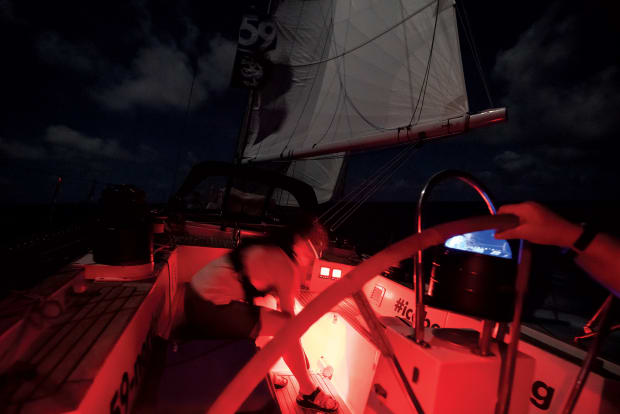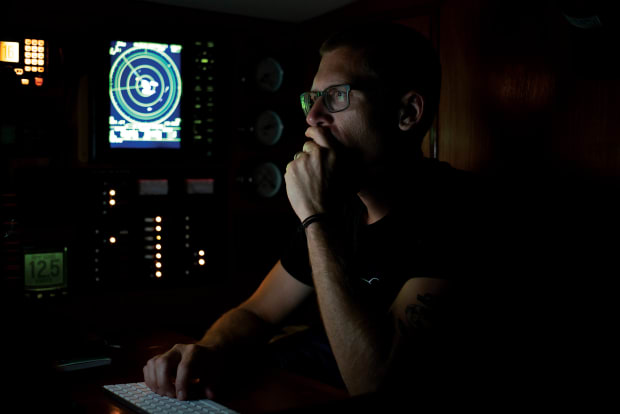
February 2, 2019. Somewhere near mid-Atlantic, on passage aboard the Swan 48, Isbjørn, from Gran Canaria to Antigua, from my personal logbook:
“Something clicked for me in the early morning hours after midnight. I had slept well before Mia woke me up at 0200 to finish her four-hour night shift. I knew I’d do something to acknowledge my mom’s birthday (she died in 2012 from brain cancer). I knew it would make me emotional, and I knew that if I didn’t do it then when I had the time and space to be by myself while everyone else slept, it wouldn’t afford me the emotional release I needed. I sat with my hands on the lifelines and feet over the side, harnessed in, and just watched the sea go by while the tears flowed.”
There is something about nighttime at sea that brings out the magic, that makes offshore passagemaking. Night sailing is not scary for me, never has been. Even as a kid growing up on the Chesapeake Bay, when we’d do our annual father-son sailing trips, we’d beg our dads for a night sail, even if for only a few miles. We knew, even then, how special it was to be under sail under the stars. Inevitably, the dads relented, even if it meant having to cut short their Happy Hour with a bourbon and coke snug at anchor. Despite the extra effort, a part of them knew it was worth it, too.
Practically speaking, night sailing offshore is far easier than night sailing on the Chesapeake. There are no buoys to look out for, no shallows to contend with, no unlit fishing boats wandering about. It’s just the ocean, the universe and you. If you’re really lucky, you might even get to see some “electric dolphins”—a rare phenomenon that occurs whenever a curious pod of dolphins swims by for a visit on an exceptionally dark, moonless night in an area where there is also an abundance of phosphorescent plankton. With a comet trail stretching out as much as 100 yards, they look like torpedoes streaking through the ocean until they abruptly hit the brakes and change course. I’ve seen it only two or three times in all my years at sea. Each time I’m stunned by how amazing it is.

At 590 north, we deliberately keep a dark cockpit at night to maintain our night vision. The only lights are the dim red glow from the compass and the red backlit sailing instruments. Under sail, when nighttime is its most magical, the masthead tricolor is the only nav light we need, and we turn off the chartplotter at the helm so it won’t ruin the mood. It takes time to train your nighttime depth perception—ship’s lights, for example, often appear far closer than they actually are. But it’s worth it.
At night, although the stakes may arguably be higher due to the lack of visibility, the routines don’t really change. Crew remain clipped-in to hard points and jacklines from the moment they leave the confines of the companionway. We hand-steer mostly, using an electronic compass, as opposed to an analog one, because it’s easier. (I know, blasphemy!) On clear nights, you can also always pick out a star to steer by, which is the best of all. Nobody leaves the safety of the cockpit without, at the very least, informing their watch partner, and, unless conditions are very mild, the skipper or mate. Before each passage, we emphasize the fact to our crews that if you go overboard at any time, day or night, you’re as good as dead, so act accordingly. You won’t be any deader just because it’s dark out.
I’m not one to preemptively reef just because the sun is going down. If the weather is stable, we’ll fly the sail the boat needs to keep moving. If the weather changes, we’ll rouse the on-call crew and throw in a reef. Once you really get to know your boat, sailhandling is done mostly by feel and muscle memory anyway, so the darkness barely matters. On a night with a bright moon and clear sky, sail changes don’t even need a headlamp.
If you’re used to doing watches with a partner, take an hour or two on an especially mellow night and stand watch all on your own. That’s when the magic really happens, when it’s just you, your thoughts and the universe spread out before you in all its immensity. My log from that same night in 2019 continues:
“I laid down on the cockpit seat and gazed up at the stars for an hour, realizing that, yeah, this here is a pretty nice place to be right now. I was reminded of my mom’s presence in my life, even in her passing. She believed in positive thinking. ‘Believe it, and it will come true,’ she preached, quoting Jimmy Buffett. She thought it, she meant it and obviously, it’s sunk in, ‘cause look where I am now, writing these words in the middle of my 4th Atlantic crossing and pursuing the only career that was ever made for me, or more accurately, by me.”
I think everyone should spend at least one night watch alone at sea to reflect on where exactly they are in their lives and how they might want to change—or not change—wherever it is they’re going. In the words of French aviator Antoine de Saint-Exupéry, author of The Little Prince and Wind, Sand and Stars, “True riches cannot be bought…There is no buying the night flight with its hundred thousand stars, its serenity, its few hours of sovereignty.” Same thing when the lights go down at sea.
Andy Schell is a veteran delivery captain and co-owner, with his wife, Mia Karlsson, of the adventure-charter company 59 North, which specializes in providing sail-training and offshore passagemaking opportunities. Visit 59-north.com for more information.
Photos courtesy of 59 degrees north
February 2022








